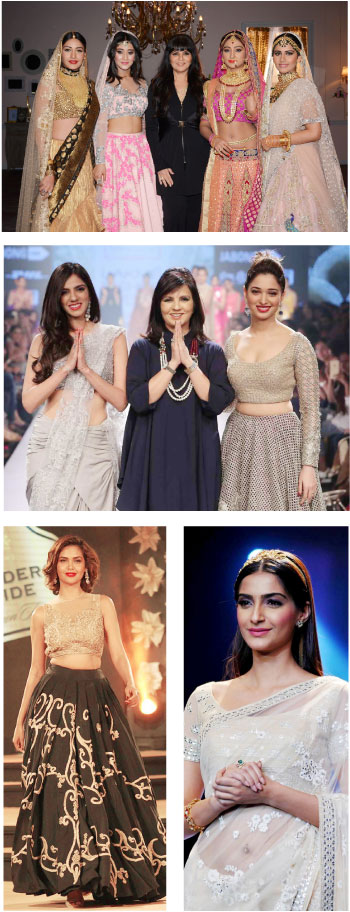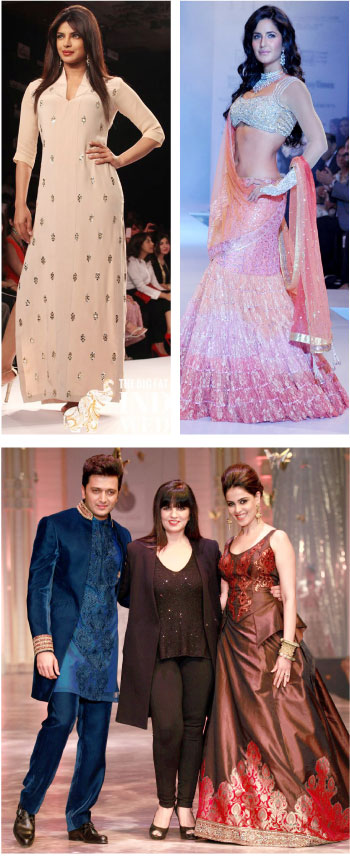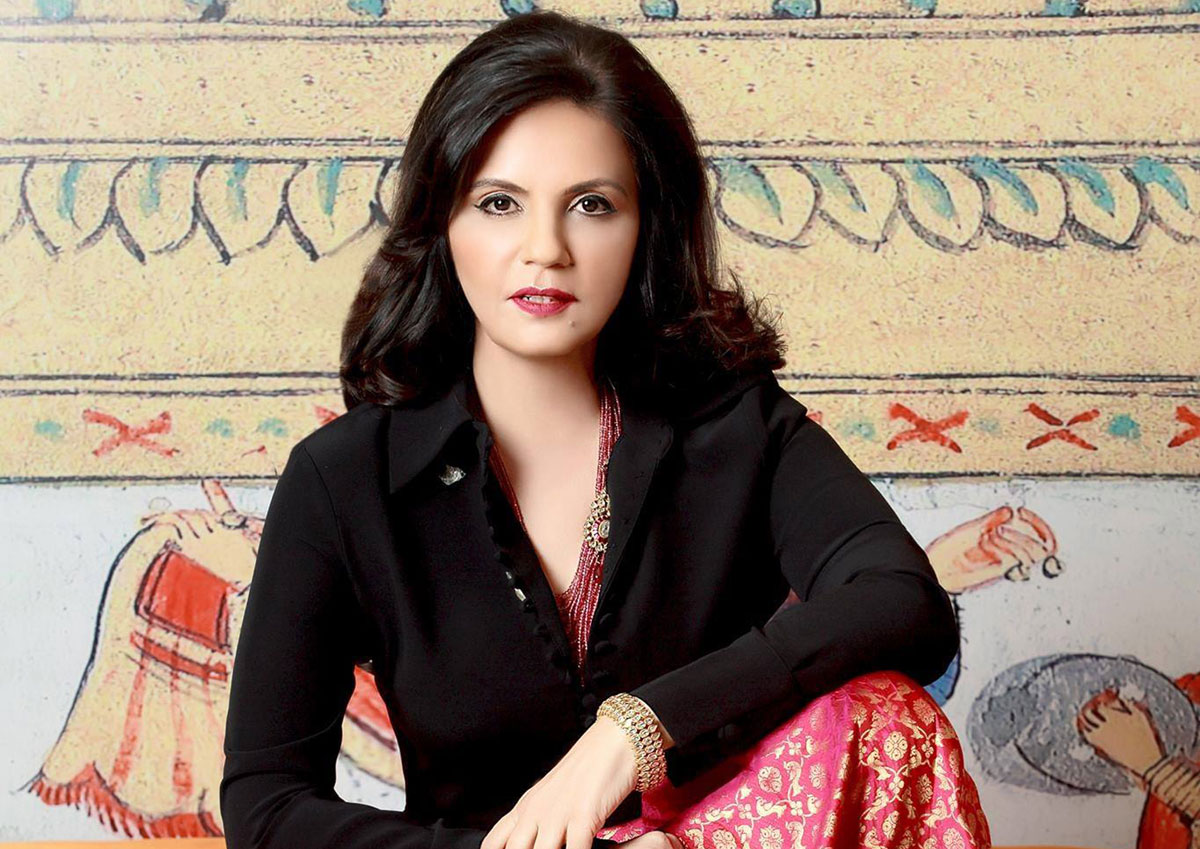Neeta Lulla “We are Amidst a Fashion Explosion”
Neeta Lulla is a costume designer and fashion stylist who has worked on over 300 films. She has been designing wedding dresses since 1985. Her name became inseparably associated with Bollywood after Aishwarya Rai and Madhuri Dixit wore her costumes in Devdas (2002), the trendsetting cult film. Her first big client was jewellery designer Varuna Jani, though Jani hadn’t started her business at the time. After that Lulla fully committed to a Bollywood client base when she designed for Swapna who was prominent in the South.This success was followed by her designs for Salma Agha and Sridevi. A notable creation from later in her career was a dress she designed for Aishwarya Rai’s wedding to Abhishek Bachchan. She crafted Rai’s pearl-encrusted lehenga for her mehendi ceremony and an additional dress for her South Indian wedding ceremony. The designer has claimed that the wedding wear that she’s created for Rakhi Sawant was her favorite. Neeta Lulla has designed for Shilpa Shetty, Aishwarya Rai, Sridevi, Swapna, Salma Agha, Isha Koppikar and Juhi Chawla. Lulla has also designed for Dimpy Ganguly, Rahul Mahajan’s ex wife. SANDEEP HATTANGADI interviews Neeta Lulla, who he says is sure to conquer the fashion arena internationally!
 Tell us about your journey in the fashion industry and how it started?
Tell us about your journey in the fashion industry and how it started?
With a brief advent to fashion magazines that I got as a kid, I opted to what I thought was a hobby course in tailoring (after getting married at an early age ) which in fact was a diploma In Pattern Making And Garment Manufacture at SNDT University’s Premlila Vithaldas Polytechnic Juhu .
Tell me who spotted your talent first in Bollywood?
Academics was not my strength but styling and coordination interested me as I had a brilliant guru in Hemant Trivedi who saw my talent and groomed me in the art of make-up,fashion choreography and styling shows. I was intrigued by the history behind world costumes but I could only grasp through listening. Textbook knowledge never fascinated me.
Go on!
In the meanwhile my college asked me to double up as a lecturer in fashion coordination. I did take it up but it initially scared the daylights out of me for over a year till I got used to it and my teaching pattern was more interactive than academical. Later on, I went to design for films both national and international clocking over 300 films with amazing experiences along the way, it’s been one hell of a journey.
How has the fashion industry evolved over the years?
We are in the midst of a major fashion explosion and there is an increased sense of awareness now, of global fashion trends. Fashion is no longer restricted to Tier 1 cities but is a growing need in Tier 2 and 3 cities as well. Today men are as cosmopolitan as women. A lot of focus is being given to promoting indigenous fashion and artisans from rural areas, which is a fantastic move by the Government of India. There are new emerging designers who are fabulous in what they have to offer. However fashion weeks and tours need to revamp drastically as there is a sense of monotony that has set in.
Tell us about your favorite Fashion Weeks in India and overseas and your experiences in places like Milan and Paris?
I believe the concept of fashion weeks is now very redundant. It’s a great platform but there needs to be an innovation. My favorites are Lakme Fashion Week and Amazon Fashion Week. I have thoroughly enjoyed my global showcases as international designers and fashion organizations are more receptive to designers coming from another land. There is an intrigue factor and especially when you couple it with tradition and legacy, it’s even more charming.
Who do you think have been the best models and ramp walkers that you have dressed over the years?
I wouldn’t like to be biased but yes I miss the days of Milind Soman, Madhu Sapre, Sheetal Malhar etc. From Bollywood it’s Sonam Kapoor and Kangana Ranaut who continually push the boundary and their aesthetic is so non conventional and I like that.
 You are a successful stylist for film stars! How different is designing costumes for them and costumes for films? Who are your favorite A List film star clients?
You are a successful stylist for film stars! How different is designing costumes for them and costumes for films? Who are your favorite A List film star clients?
Costume design is always based on the scripts and the perception of the director, the comfort level of the actors and the color scheme of the canvas of the film and you style a look from head-to-toe to enhance characterization. Real life fashion design is based on the designer’s perception of fashion trends. Garments are designed keeping in mind the consumer requirements and price points. Fabric and garment finish play a very important role in these outfits. Having worked with most of the industry’s best,I feel that each actor has a very distinctive style and the rapport I share with them all make all of them my favorites.
Who have been your favorite designers, your idols and inspirations?
The late Frida Kahlo has been a very big inspiration for me as she pursued her work and creative talent against all odds and was a holistic woman of substance. Shahab Durazi for his impeccable finish, Azzedine Alia for his figure hugging cuts and silhouettes ,Alexandra McQueen for his luxuriant yet quirky aesthetics with a message that came through from time to time from his collections and Dolce Gabbana for their fantastic sense of blending color and prints and creative vibrant collections.
What do you think of the trend of fashion schools that have mushroomed all over the place and your advice for budding fashion designers?
I think it’s great that there are so many fashion schools imparting knowledge to people who truly want to pursue their career in this direction. I love interacting with students and mentoring them. I am currently an integral part of Hamstech institute in Hyderabad and Whistling Woods international school of fashion. Also, my advice to young designers is that academics paves a strong foundation to your work in future.
What is your favorite designer wear?
I utilize Paithani, the ancient technique of tapestry that combines multiple threads of different colors and incorporates gold and silver threads woven together to create a dynamic piece of silk. One of the most notable Paithani collections was shown in February 2016 at the Make In India initiative. At this show, I showcased a wide range of pieces including flowing lehangas, long kurtas, jackets, dhoti pants, sarong skirts — all of which were embroidered, according to the Paithani style.


